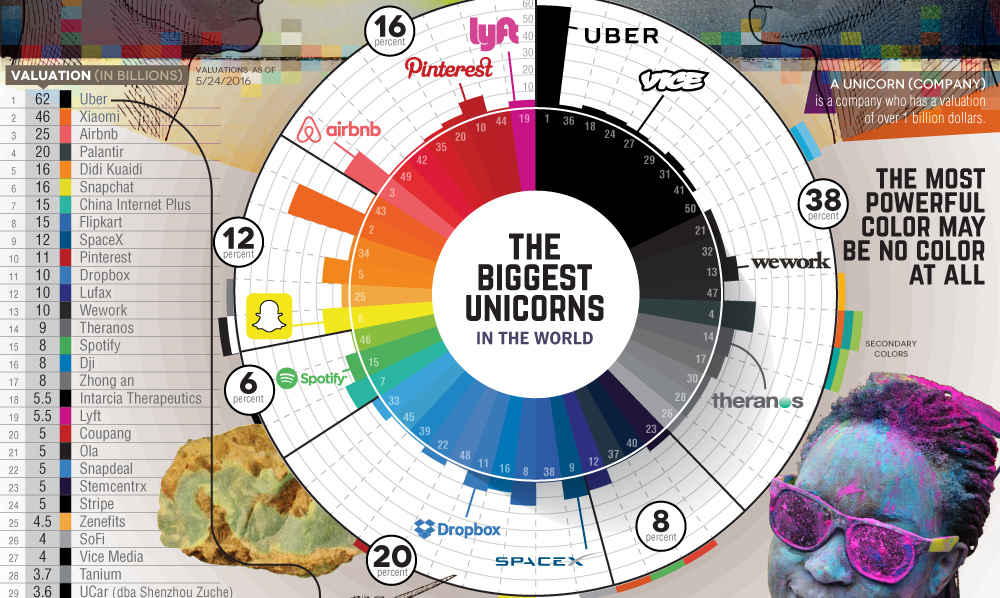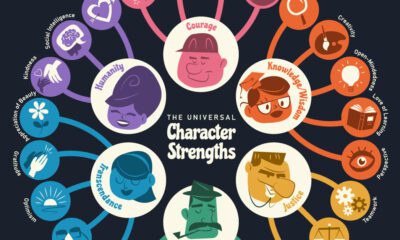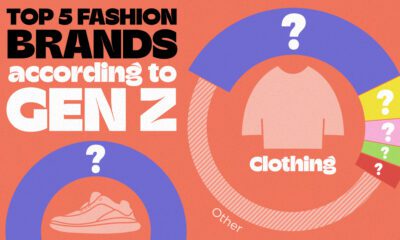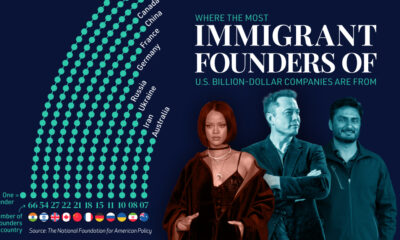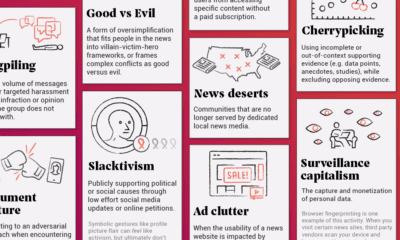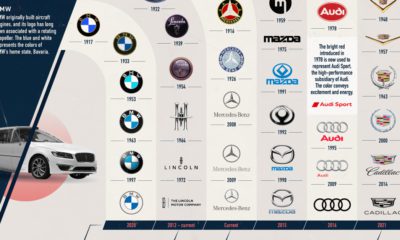Technology
The Psychology of Color in Business
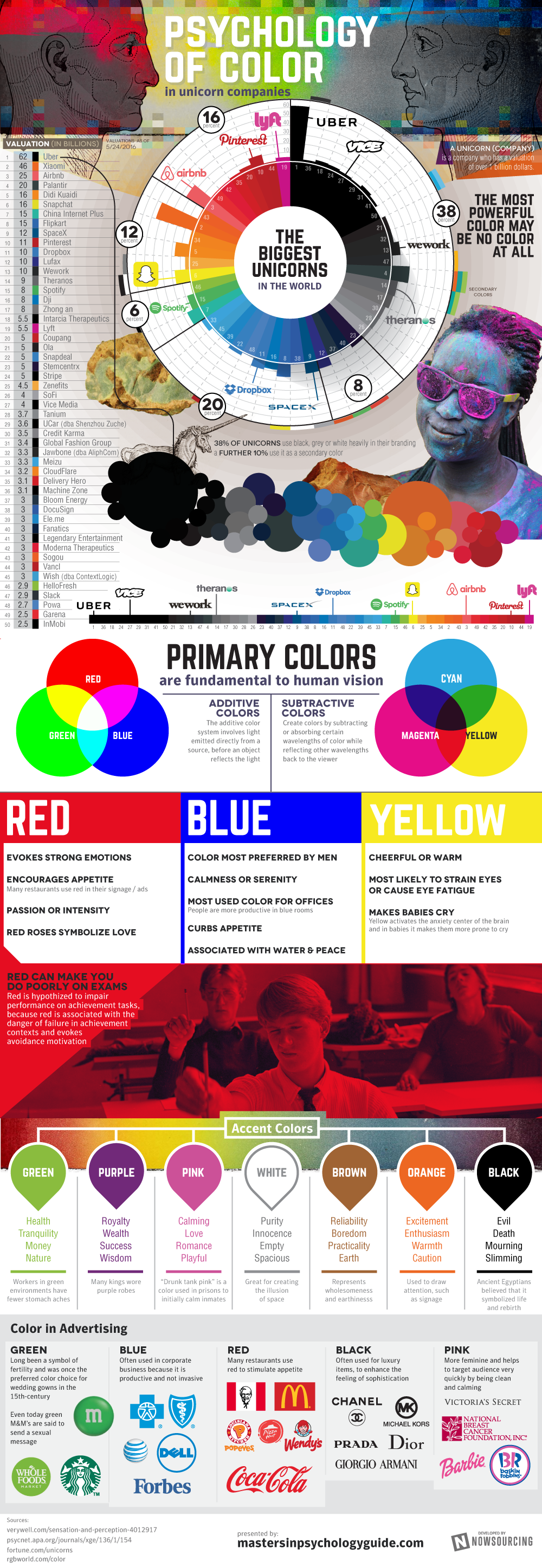
The Psychology of Color in Business
What do the colors in your company’s branding tell customers?
Today’s infographic, by the Masters in Psychology Guide, is on the psychology of color in business. It analyzes the colors used by major tech startups as well as by prominent consumer brands in their advertising.
Unicorn Colors
Out of the largest 50 unicorns, tech startups that have achieved valuations of $1 billion or more, the most common primary branding color was black or grey. A total of 38% of companies, including stalwarts like Uber, Vice, and WeWork, rely on these hues for their outward appearance.
Blue is well-known as a strong business color, and it is no surprise that 20% of the top 50 unicorns focus on blue as their primary branding color. Dropbox and SpaceX are among the companies that are following in IBM’s “Big Blue” branding path here.
The red end of the spectrum makes up 16% of companies (including Pinterest and Airbnb), with yellow at 12% (including Snapchat), and green at just 6%. A green palette was least used for primary branding by unicorns, with Spotify being a rare exception.
The Psychology of Color in Branding and Ads
It’s not just tech startups that key in on color to help differentiate their brands. Companies, including some of the best-known consumer brands, have focused on color in their branding, advertisements, and communications for years.
Red is a color that allegedly stimulates appetite. That may explain why fast-food restaurants like McDonald’s, KFC, Pizza Hut, Wendy’s, and Popeye’s all heavily use red in their brands.
Black is all about the feeling of sophistication. Some of the largest luxury brands in the world use black as a primary branding color, including Chanel, Michael Kors, Prada, Dior, or Georgio Armani.
Blue is viewed as productive, but not invasive. It has been the color of choice for large corporate brands like IBM, AT&T, and Forbes.
Lastly, green is a symbol of fertility, and pink is chosen for a feminine feel.
Technology
Visualizing AI Patents by Country
See which countries have been granted the most AI patents each year, from 2012 to 2022.

Visualizing AI Patents by Country
This was originally posted on our Voronoi app. Download the app for free on iOS or Android and discover incredible data-driven charts from a variety of trusted sources.
This infographic shows the number of AI-related patents granted each year from 2010 to 2022 (latest data available). These figures come from the Center for Security and Emerging Technology (CSET), accessed via Stanford University’s 2024 AI Index Report.
From this data, we can see that China first overtook the U.S. in 2013. Since then, the country has seen enormous growth in the number of AI patents granted each year.
| Year | China | EU and UK | U.S. | RoW | Global Total |
|---|---|---|---|---|---|
| 2010 | 307 | 137 | 984 | 571 | 1,999 |
| 2011 | 516 | 129 | 980 | 581 | 2,206 |
| 2012 | 926 | 112 | 950 | 660 | 2,648 |
| 2013 | 1,035 | 91 | 970 | 627 | 2,723 |
| 2014 | 1,278 | 97 | 1,078 | 667 | 3,120 |
| 2015 | 1,721 | 110 | 1,135 | 539 | 3,505 |
| 2016 | 1,621 | 128 | 1,298 | 714 | 3,761 |
| 2017 | 2,428 | 144 | 1,489 | 1,075 | 5,136 |
| 2018 | 4,741 | 155 | 1,674 | 1,574 | 8,144 |
| 2019 | 9,530 | 322 | 3,211 | 2,720 | 15,783 |
| 2020 | 13,071 | 406 | 5,441 | 4,455 | 23,373 |
| 2021 | 21,907 | 623 | 8,219 | 7,519 | 38,268 |
| 2022 | 35,315 | 1,173 | 12,077 | 13,699 | 62,264 |
In 2022, China was granted more patents than every other country combined.
While this suggests that the country is very active in researching the field of artificial intelligence, it doesn’t necessarily mean that China is the farthest in terms of capability.
Key Facts About AI Patents
According to CSET, AI patents relate to mathematical relationships and algorithms, which are considered abstract ideas under patent law. They can also have different meaning, depending on where they are filed.
In the U.S., AI patenting is concentrated amongst large companies including IBM, Microsoft, and Google. On the other hand, AI patenting in China is more distributed across government organizations, universities, and tech firms (e.g. Tencent).
In terms of focus area, China’s patents are typically related to computer vision, a field of AI that enables computers and systems to interpret visual data and inputs. Meanwhile America’s efforts are more evenly distributed across research fields.
Learn More About AI From Visual Capitalist
If you want to see more data visualizations on artificial intelligence, check out this graphic that shows which job departments will be impacted by AI the most.
-

 Mining1 week ago
Mining1 week agoGold vs. S&P 500: Which Has Grown More Over Five Years?
-

 Markets2 weeks ago
Markets2 weeks agoRanked: The Most Valuable Housing Markets in America
-

 Money2 weeks ago
Money2 weeks agoWhich States Have the Highest Minimum Wage in America?
-

 AI2 weeks ago
AI2 weeks agoRanked: Semiconductor Companies by Industry Revenue Share
-

 Markets2 weeks ago
Markets2 weeks agoRanked: The World’s Top Flight Routes, by Revenue
-

 Countries2 weeks ago
Countries2 weeks agoPopulation Projections: The World’s 6 Largest Countries in 2075
-

 Markets2 weeks ago
Markets2 weeks agoThe Top 10 States by Real GDP Growth in 2023
-

 Demographics2 weeks ago
Demographics2 weeks agoThe Smallest Gender Wage Gaps in OECD Countries
